Blogs
Kama EV EW1: The Perfect Electric Pickup for Nepal
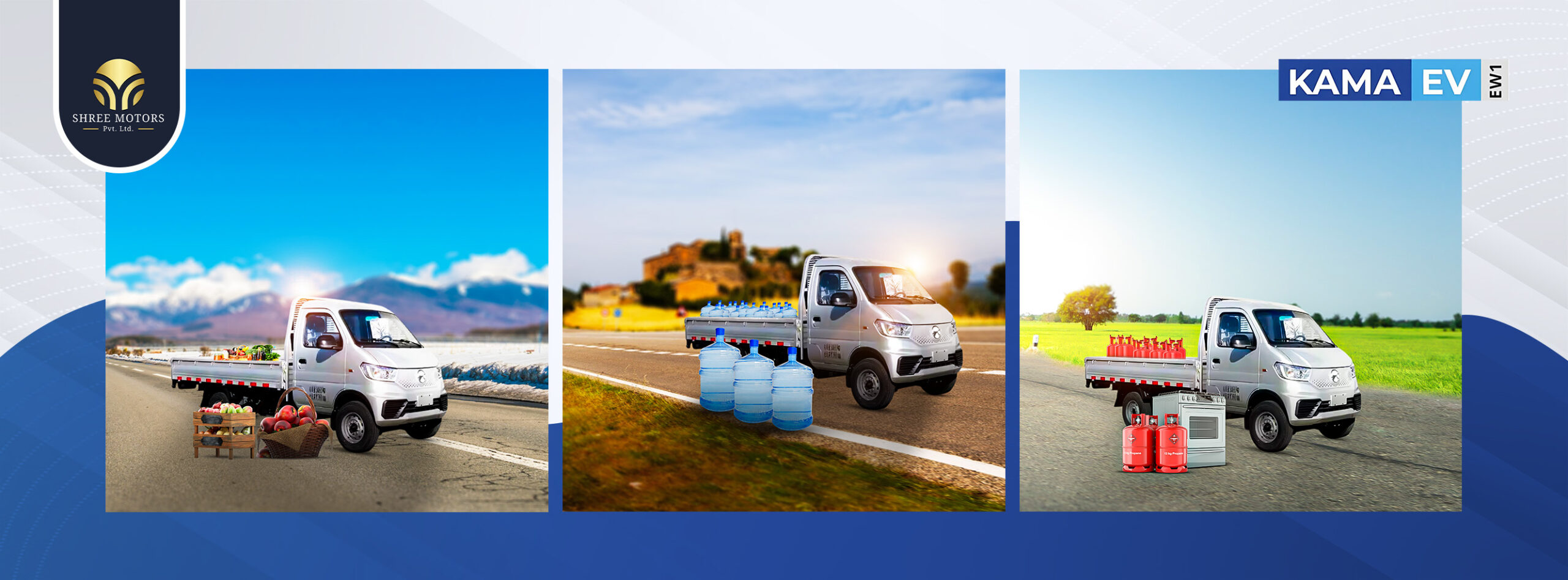
Nepal’s demand for electric vehicles (EVs) is steadily growing, and it’s no surprise. With rising fuel costs and a push toward eco-friendly solutions, EVs offer an excellent alternative. In this context, the Kama EV EW1 is a fantastic choice, particularly for farmers and small business owners. In this article, we’ll explore why the Kama EV EW1 might be the right pickup for you, along with its price, features, and comparisons.
Why Choose Kama EV EW1?
The Kama EV EW1 is an electric pickup truck designed for hardworking individuals who need efficiency and durability. It combines an impressive payload capacity with cost-effective operations and an environmentally friendly design. This vehicle can be a long-term money-saver in Nepal, where fuel prices are high.
Key Features
- Price:
In Nepal, the Kama EV EW1 is priced at NPR 25.90 lakhs. This is a competitive price point, making it accessible for both businesses and individuals. - Payload Capacity:
The Kama EV EW1 can carry a payload of 1.5 tons (equivalent to 1500 Kg), making it ideal for transporting heavy goods. This is especially beneficial for farmers and small-scale enterprises. - Range:
The EV offers an impressive range of 260 km on a single charge, suitable for daily operations and medium-distance travel. - Charging Time:
- Standard charging: 8–10 hours
- Fast charging: Supports AC/DC
This flexibility ensures that the vehicle is always ready for action.
- Design and Features:
- A modern, sleek design that looks professional.
- Power steering for a comfortable driving experience.
- A spacious loading area to accommodate various goods.
Comparison with Other Pickups (Kama EV EW1 vs. Diesel Pickups)
| Feature | Kama EV EW1 | Diesel Pickups |
|---|---|---|
| Price | NPR 25.90 lakhs | NPR 30–35 lakhs (avg.) |
| Fuel Cost | Low (electric) | High (diesel/petrol) |
| Payload Capacity | 1.5 tons | 1.5 tons (some models) |
| Charging/Refueling | Supports AC/DC | 5 minutes |
| Maintenance Costs | Low | High |
The Kama EV EW1 is a more economical and environmentally friendly option compared to traditional diesel pickups, especially for long-term use.
Who Should Buy the Kama EV EW1?
- Farmers:
Ideal for transporting farming tools, fertilizers, and produce. - Small Business Owners:
Perfect for delivering goods and managing inventory transportation. - Urban Businesses:
Great for city-based operations that require efficient and cost-effective delivery solutions.
Payload Power: Carry More with Kama EV EW1
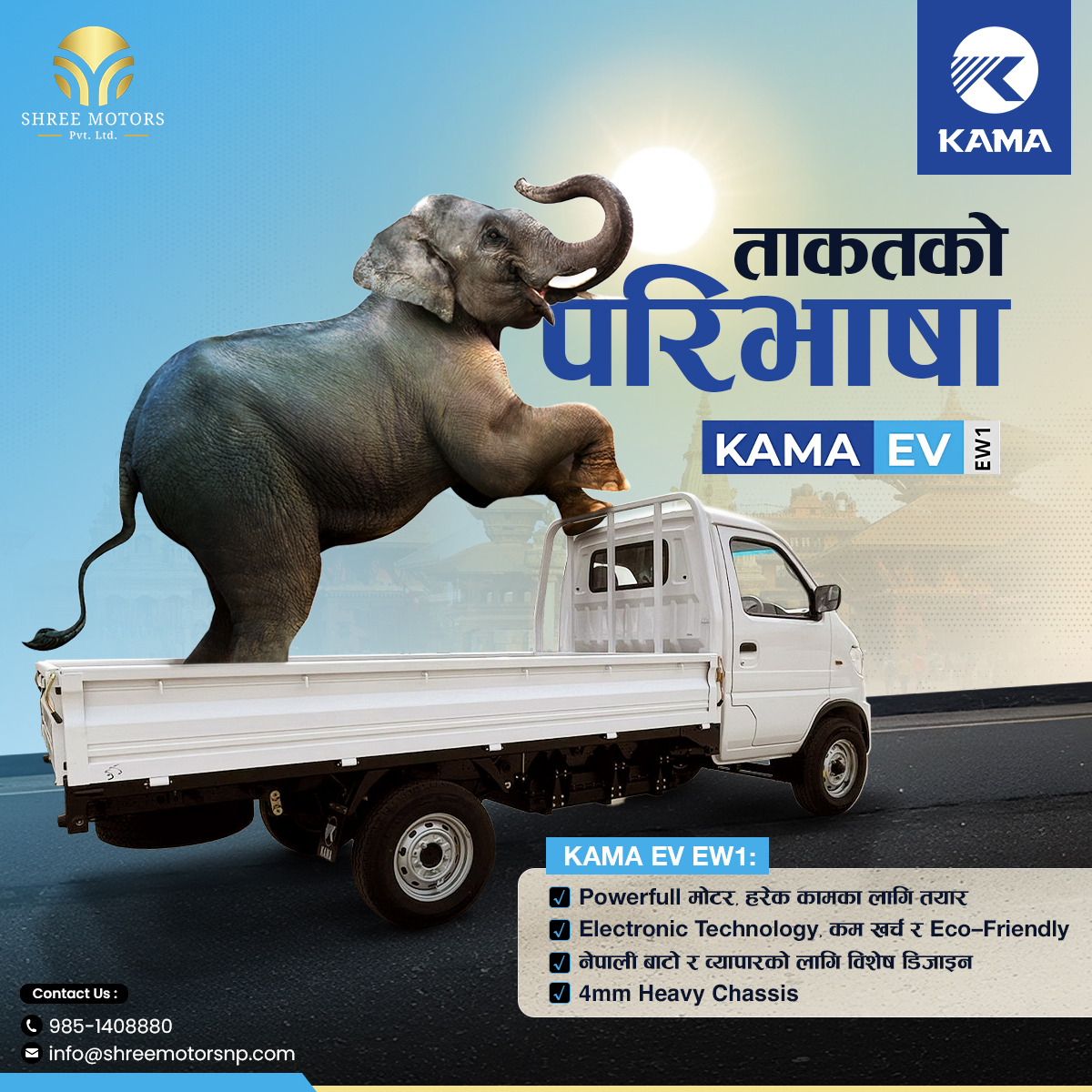
Electric Efficiency: 260 km Range on a Single Charge
- The Kama EV EW1 delivers an impressive range of 260 km on a single charge, perfect for daily use and medium-distance trips, ensuring efficiency and cost savings.
Charging Time Simplified: Standard vs. Fast Charging
- Kama EV EW1 offers flexible charging options: Standard charging takes 8–10 hours, while fast charging Supports both AC/DC.
Cost Comparison: Electric Pickup vs. Diesel Pickup
- Switch to savings with an electric pickup! Kama EV EW1 has significantly lower running costs compared to diesel pickups—spend less on fuel, maintenance, and long-term operations.
Kama EV EW1: Built for Farmers and Business Owners
- The Kama EV EW1 is designed with farmers and business owners in mind, offering a 1.5-ton payload capacity, 260 km range, and cost-effective performance for reliable and efficient transportation.
Eco-Friendly Advantage: Save Money, Save the Planet
- The Kama EV EW1 is not just a vehicle—it’s a step toward sustainability. Enjoy lower running costs while reducing carbon emissions, making it a smart choice for your wallet and the environment.
Top Features of Kama EV EW1 at a Glance
- 1.5 Tons Payload Capacity: Perfect for heavy-duty tasks.
- 260 km Range: Efficient for daily and medium-distance travel.
- Fast & Standard Charging: Supports AC/DC (fast) or 8–10 hours (standard).
- Eco-Friendly: Zero emissions, reducing your carbon footprint.
- Cost-Effective: Save on fuel and maintenance.
- Modern Design: Stylish and practical for work and business.
Why Electric is the Future for Nepali Businesses
- Lower Operational Costs: Save significantly on fuel and maintenance.
- Government Incentives: Enjoy tax benefits and subsidies for EVs in Nepal.
- Sustainability: Align with global trends toward eco-friendly practices.
- Efficiency: Reliable performance with a 260 km range per charge.
- Long-Term Savings: Reduced running costs mean more profit for your business.
Conclusion
The Kama EV EW1 is a well-rounded package offering excellent capacity, cost-effective performance, and durability. NPR 25.90 lakhs is a great investment for your business and daily operations. If you’re searching for the perfect electric pickup, the Kama EV EW1 should be at the top of your list.
Experience It Yourself: Shree Motors Offers Free Test Drives for Kama EV EW1! Call at 9851408880
Blogs
Private Power Producers Protest ‘Take and Pay’ Provision in Budget
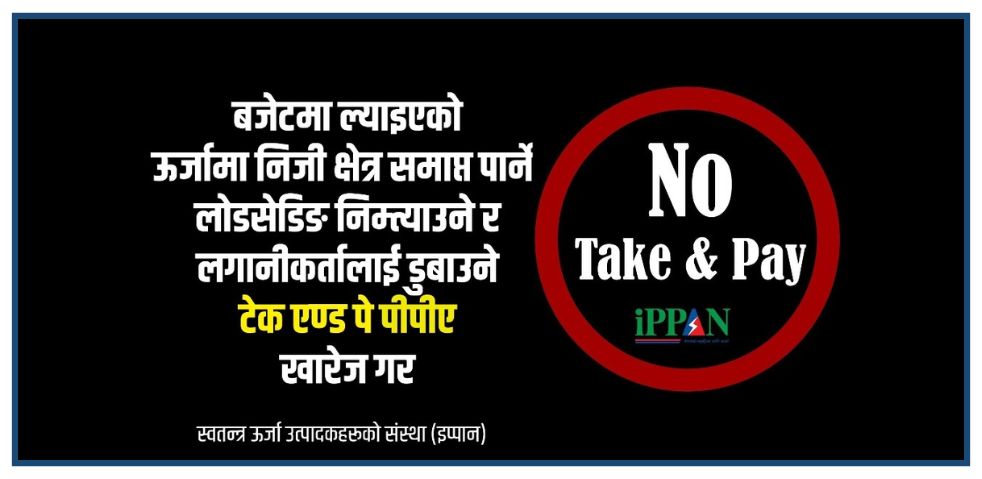
Private energy entrepreneurs in Nepal have taken to social media, protesting the government’s decision to introduce the ‘Take and Pay’ (Liu Ra Tir) system for electricity purchase agreements (PPA) in the new fiscal year budget.
Under this system, the government would only pay for the electricity it uses, instead of paying for the total electricity generated by hydropower projects. Entrepreneurs argue this move could severely hurt the private sector, discourage investment, and push the country back toward power shortages.
Online Campaign Targets Top Officials
Energy producers are now directly appealing to key government figures. They have publicly tagged Prime Minister Pushpa Kamal Dahal, Finance Minister Barshaman Pun, Energy Minister Shakti Bahadur Basnet, and NEA Executive Director Kulman Ghising on social media, urging them to withdraw the Take and Pay provision.
This digital campaign comes just days after developers handed over a memorandum to the Prime Minister and bombarded top officials with hundreds of SMS messages requesting the same.
Why Are Entrepreneurs Worried?
Entrepreneurs claim that this decision will:
- Weaken the private sector’s role in the energy industry
- Risk the return of load-shedding (power cuts)
- Causes financial losses to investors
- Damage the overall economy
The Independent Power Producers’ Association of Nepal (IPPAN) has strongly opposed the provision. According to IPPAN’s Vice President and protest coordinator Mohan Kumar Dangi, the policy shift will discourage private hydropower development, especially for Run-of-River (RoR) projects, which are most affected by the new model.
Ongoing Protests and Next Steps
Since Asar 6, private power developers have been staging a phase-wise protest. On the third day of their movement, they moved their campaign to social media to raise public awareness and pressure the government.
Dangi warned that if the government ignores these peaceful efforts, the protests will escalate. Planned steps include:
- Lobbying political party leaders in Parliament
- Launching a nationwide street protest
- Returning the keys of privately built hydropower projects to the government — a symbolic act of handing over control
Background: The Budget Controversy
The controversy started when the budget for FY 2082/83 (announced on Jestha 15) stated that all future PPAs for RoR hydropower projects would be done under the Take and Pay model only. This was a major change from the previous Take or Pay model, where producers were paid even if electricity wasn’t consumed, offering more security for private investors.
Conclusion
The ‘Take and Pay’ decision has sparked serious concerns across Nepal’s private energy sector. Developers fear this could lead to a slowdown in future hydropower investments, and possibly, a return to unstable electricity supply. With pressure mounting both online and offline, the government’s next move will be critical for the future of Nepal’s energy landscape.
Blogs
Nepal Rastra Bank to Withdraw NPR 60 Billion from the Banking System on Monday
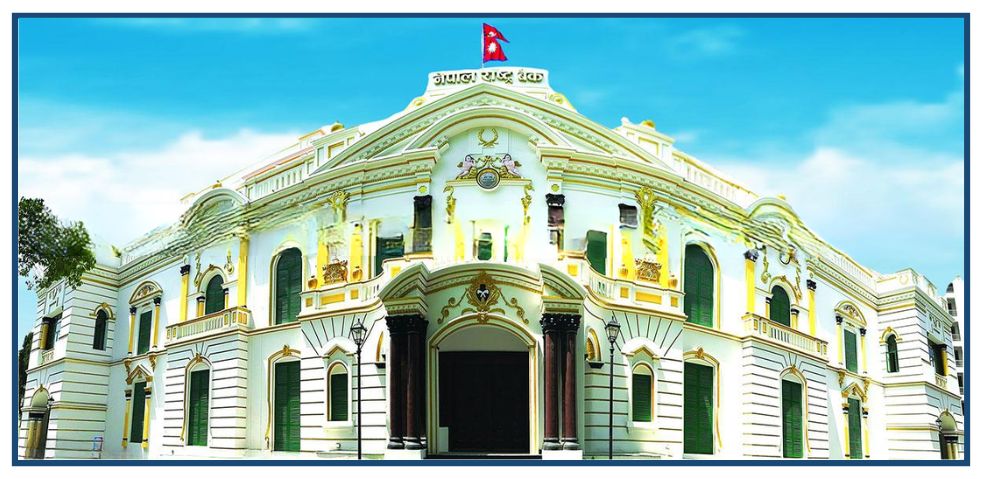
Nepal Rastra Bank (NRB), the central bank of Nepal, has announced it will withdraw NPR 60 billion in deposits from the banking system on Monday through a deposit collection auction. This move comes as excess liquidity continues to remain in the banking sector since the beginning of the current fiscal year 2081/82.
According to NRB, the withdrawal will be conducted through the online bidding system, and the interest rate will be determined through competitive bidding. The collected amount, including both principal and interest, will be settled on Shrawan 18, 2082 (August 2, 2025).
Key Auction Details
- Total Amount: NPR 60 billion
- Minimum Bid Amount: NPR 100 million
- Bid Increments: Must be divisible by NPR 50 million
- Eligible Participants: Class ‘A’, ‘B’, and ‘C’ licensed banks and financial institutions
- Auction Method: Competitive bidding via NRB’s online platform
- Maturity & Settlement Date: Shrawan 18, 2082
Why Is the Central Bank Taking This Step?
As per NRB, the banking system is currently holding excessive liquidity, with total deposits crossing NPR 7 trillion. However, this liquidity is not being effectively utilized, as loan disbursement has remained slow. This reflects a lack of investor confidence and limited credit demand in the economy.
To control liquidity and stabilize the financial market, NRB has been consistently withdrawing funds using monetary tools since the start of the fiscal year. Tools like reverse repo, outright sale, deposit collection, and bond issuance are being used depending on the situation, whether there is too much or too little money in the system.
Recent Trends in Liquidity Control
Last week alone, NRB withdrew NPR 90 billion in a single day, highlighting the ongoing efforts to manage surplus liquidity. The central bank is using such actions not only when there is an overflow of money but also in times of shortage, to maintain balance in the financial system.
Conclusion
The decision to withdraw NPR 60 billion on Monday shows that Nepal Rastra Bank is actively managing liquidity to ensure financial stability. With a large amount of unused funds in the system, these measures are crucial to prevent inflation, reduce financial risk, and encourage more effective use of capital in the economy.
Blogs
52-Week Low & High Microfinance Shares in Nepal: Current Status and Future Outlook

The microfinance sector in Nepal has been moving sideways for a long time. The group sub-index has been fluctuating between 4,600 and 5,600. Recently, the index reached a swing high of nearly 4,900 but then closed at 4,671.74.
The national budget did not bring any immediate changes that could affect the capital market. So, investors are now waiting for the upcoming monetary policy. After the newly appointed Governor of Nepal Rastra Bank, Dr. Bishwanath Paudel, reduced the risk weight on margin loans from 125% to 100% during the third quarterly review, investor confidence grew.
Investors now hope that the following changes will be introduced in the next monetary policy:
- Removal of the current Rs. 15 crore limit on individual investment
- Removal of the 15% dividend cap on microfinance institutions
- Permission for banks and financial institutions to trade shares for less than one year
Governor Paudel’s public remarks have made investors hopeful that the upcoming monetary policy will be share-market friendly.
Despite the pressure on the market at the end of Ashar, investors are optimistic about a rebound afterward. Experts say microfinance and insurance stocks—whose prices have not surged yet compared to others—might offer better opportunities in the coming days.
Top 20 Microfinance Companies Nearest to 52-Week Low

Some microfinance companies are trading close to their 52-week low prices. These stocks may offer good value for long-term investors. Here are some examples:
-
Nesdo Samriddhi Microfinance had a high of Rs. 2,641 and a low of Rs. 1,540 in the past year. It is currently trading near its lowest point.
-
Sana Kisan Bikas Microfinance and Jan Utthan Community Microfinance are both trading less than 1% above their 52-week lows.
-
Jeevan Bikas, NIC Asia, Infinity, Suryodaya Womi, RSDC, Asha, and Swabalamban Microfinance are trading just 1–3% above their yearly lows.
-
Other companies like Unique Nepal, Bijaya, Forward, Nirdhan Utthan, Diprox, Mahuli, Nerude Mirmire, National, Samata Gharelu, and Laxmi Microfinance are also trading only 3–5.5% above their low points.
According to experts, these stocks could be worth watching for those looking to invest at lower prices.
Microfinance Stocks Near 52-Week High

Interestingly, a few companies are still trading near their 52-week highs even though the overall market is in a downtrend:
-
Unnati Sahakarya Microfinance reached a high of Rs. 5,276 and is now trading at around Rs. 1,804.
-
CYCL Nepal Microfinance had a high of Rs. 1,958 and is still trading at Rs. 1,615, which is relatively strong.
On the other hand, many microfinance stocks are trading 20–40% below their 52-week highs:
-
Aatmanirbhar, Mahila, Grameen Bikas, Kalika, Global IME, Chhimek, Mero Microfinance, and Abhiyan are all trading 22% to 31% below their highs.
-
NMB, First Microfinance, RSDC, Laxmi, Nirdhan Utthan, Diprox, Sana Kisan, Mithila, National, and Swabhiman are trading 34% to 44% below their 52-week highs.
These stocks may still have room to rise if the market recovers and favorable policies are introduced.
Conclusion
The microfinance sector in Nepal is at a turning point. While the market has been moving sideways, investor confidence is building, especially with hopes for a supportive monetary policy. Stocks near their 52-week lows may offer attractive entry points, while those holding near their highs show relative strength.
For both new and experienced investors, this could be a good time to study the microfinance sector closely and plan for the long term. As always, careful research and risk assessment are essential before making any investment decisions.
-
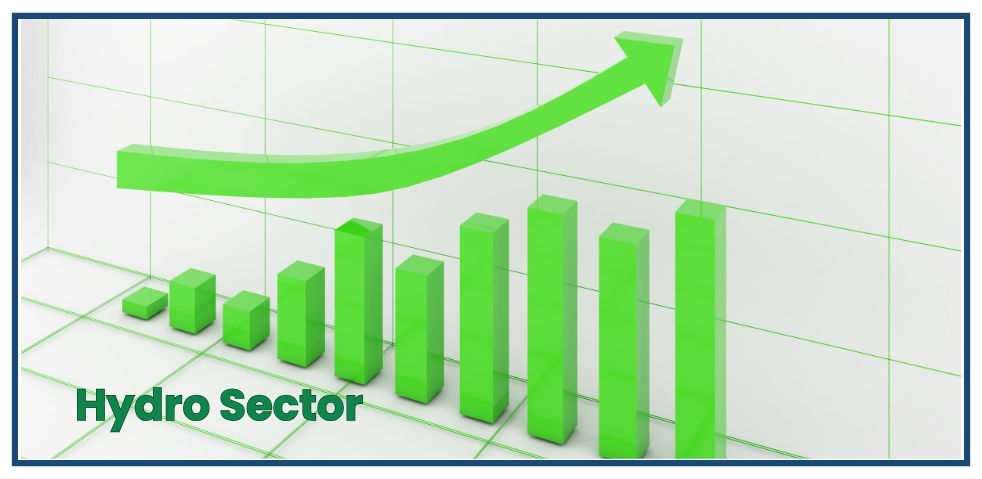
 Blogs4 days ago
Blogs4 days agoHydropower Gains 7.8% in One Month, Outperforming All Sectors
-
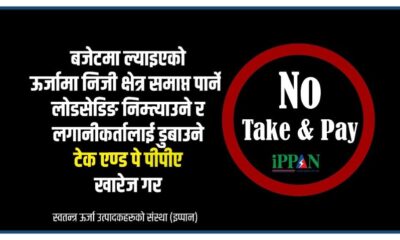
 Blogs12 hours ago
Blogs12 hours agoPrivate Power Producers Protest ‘Take and Pay’ Provision in Budget
-
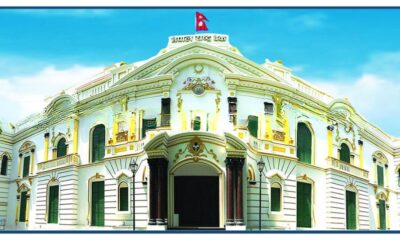
 Blogs12 hours ago
Blogs12 hours agoNepal Rastra Bank to Withdraw NPR 60 Billion from the Banking System on Monday
-

 Blogs13 hours ago
Blogs13 hours ago52-Week Low & High Microfinance Shares in Nepal: Current Status and Future Outlook
-

 Blogs1 year ago
Blogs1 year agoList of Stock Brokers in Nepal with NEPSE TMS Login – Updated
-

 Blogs14 hours ago
Blogs14 hours agoAsian Life Insurance to Issue Rights Shares from Asar 25
-

 Blogs6 months ago
Blogs6 months agoSiuri Nyadi Power Limited Added to IPO Pipeline by SEBON
-
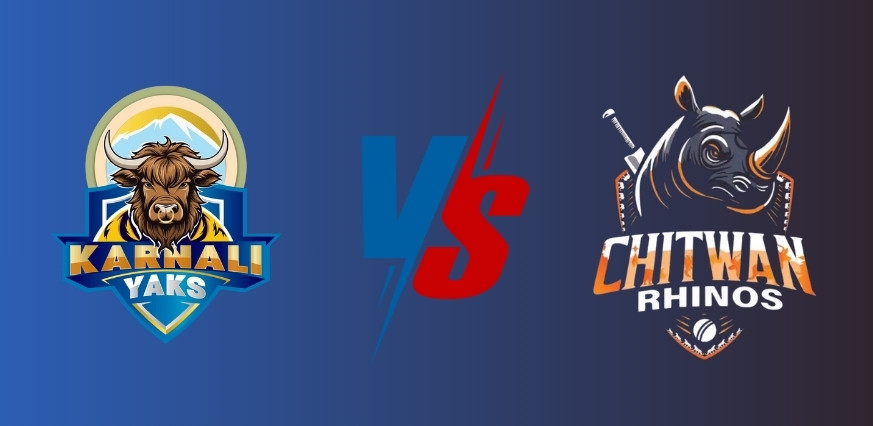
 Blogs7 months ago
Blogs7 months agoKarnali Yaks Win By 6 Wickets Against Chitwan Rhinos | Nepal Premier League 2024


